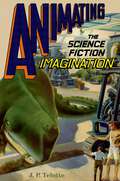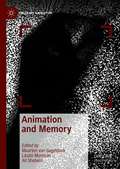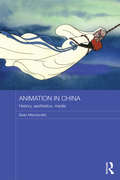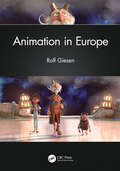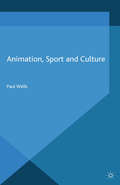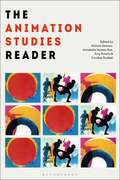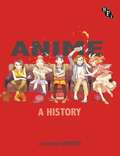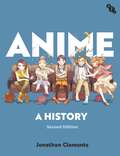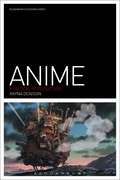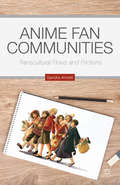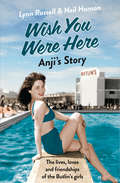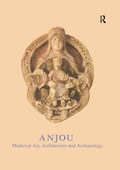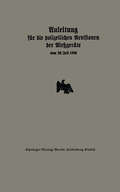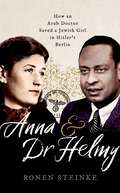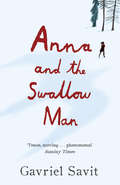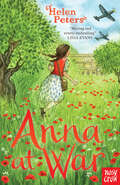- Table View
- List View
Animating the Science Fiction Imagination
by J.P. TelotteLong before flying saucers, robot monsters, and alien menaces invaded our movie screens in the 1950s, there was already a significant but overlooked body of cinematic science fiction. Through analyses of early twentieth-century animations, comic strips, and advertising, Animating the Science Fiction Imagination unearths a significant body of cartoon science fiction from the pre-World War II era that appeared at approximately the same time the genre was itself struggling to find an identity, an audience, and even a name. In this book, author J.P. Telotte argues that these films helped sediment the genre's attitudes and motifs into a popular culture that found many of those ideas unsettling, even threatening. By binding those ideas into funny and entertaining narratives, these cartoons also made them both familiar and non-threatening, clearing a space for visions of the future, of other worlds, and of change that could be readily embraced in the post-war period.
Animation and Memory (Palgrave Animation)
by László Munteán Maarten Van Gageldonk Ali ShobeiriThis book examines the role of memory in animation, as well as the ways in which the medium of animation can function as a technology of remembering and forgetting. By doing so, it establishes a platform for the cross-fertilization between the burgeoning fields of animation studies and memory studies. By analyzing a wide range of different animation types, from stop motion to computer animation, and from cell animated cartoons to painted animation, this book explores the ways in which animation can function as a representational medium. The five parts of the book discuss the interrelation of animation and memory through the lens of materiality, corporeality, animation techniques, the city, and animated documentaries. These discussions raise a number of questions: how do animation films bring forth personal and collective pasts? What is the role of found footage, objects, and sound in the material and affective dimensions of animation? How does animation serve political ends? The essays in this volume offer answers to these questions through a wide variety of case studies and contexts. The book will appeal to both a broad academic and a more general readership with an interest in animation studies, memory studies, cultural studies, comparative visual arts, and media studies.
Animation in China: History, Aesthetics, Media (Routledge Contemporary China Series)
by Sean MacdonaldBy the turn of the 21st century, animation production has grown to thousands of hours a year in the People’s Republic of China (PRC). Despite this, and unlike American blockbuster productions and the diverse genres of Japanese anime, much animation from the PRC remains relatively unknown. This book is an historical and theoretical study of animation in the PRC. Although the Wan Brothers produced the first feature length animated film in 1941, the industry as we know it today truly began in the 1950s at the Shanghai Animation Film Studio (SAFS), which remained the sole animation studio until the 1980s. Considering animation in China as a convergence of the institutions of education, fine arts, literature, popular culture, and film, the book takes comparative approaches that link SAFS animation to contemporary cultural production including American and Japanese animation, Pop Art, and mass media theory. Through readings of classic films such as Princess Iron Fan, Uproar in Heaven, Princess Peacock, and Nezha Conquers the Dragon King, this study represents a revisionist history of animation in the PRC as a form of "postmodernism with Chinese characteristics." As a theoretical exploration of animation in the People’s Republic of China, this book will appeal greatly to students and scholars of animation, film studies, Chinese studies, cultural studies, political and cultural theory.
Animation in China: History, Aesthetics, Media (Routledge Contemporary China Series)
by Sean MacdonaldBy the turn of the 21st century, animation production has grown to thousands of hours a year in the People’s Republic of China (PRC). Despite this, and unlike American blockbuster productions and the diverse genres of Japanese anime, much animation from the PRC remains relatively unknown. This book is an historical and theoretical study of animation in the PRC. Although the Wan Brothers produced the first feature length animated film in 1941, the industry as we know it today truly began in the 1950s at the Shanghai Animation Film Studio (SAFS), which remained the sole animation studio until the 1980s. Considering animation in China as a convergence of the institutions of education, fine arts, literature, popular culture, and film, the book takes comparative approaches that link SAFS animation to contemporary cultural production including American and Japanese animation, Pop Art, and mass media theory. Through readings of classic films such as Princess Iron Fan, Uproar in Heaven, Princess Peacock, and Nezha Conquers the Dragon King, this study represents a revisionist history of animation in the PRC as a form of "postmodernism with Chinese characteristics." As a theoretical exploration of animation in the People’s Republic of China, this book will appeal greatly to students and scholars of animation, film studies, Chinese studies, cultural studies, political and cultural theory.
Animation in Europe
by Rolf GiesenThere is a lot one could say about animation in Europe, but above all, there is no consistent European animation. It is as disparate as the various countries involved. Audiences will certainly recognize American or Japanese animation, but in Europe, it can range from Czech, Polish, and Hungarian to Greek, Italian, Spanish, Portuguese, French, and British. Animation in Europe provides a comprehensive review of the history and current situation of animation in over 20 European countries. It features numerous interviews with artists and producers, including rare documents and firsthand accounts that illustrate the rich history of animation in Europe. Additional features include • An extensive chronology with key events in European animation • A Who’s Who of producers, directors, writers, and animators working in Europe • An examination of the origin of European animation and its influence Animation in Europe is the first book devoted entirely to this topic and, therefore, will be of value for animation buffs as well as practitioners and researchers.
Animation in Europe
by Rolf GiesenThere is a lot one could say about animation in Europe, but above all, there is no consistent European animation. It is as disparate as the various countries involved. Audiences will certainly recognize American or Japanese animation, but in Europe, it can range from Czech, Polish, and Hungarian to Greek, Italian, Spanish, Portuguese, French, and British. Animation in Europe provides a comprehensive review of the history and current situation of animation in over 20 European countries. It features numerous interviews with artists and producers, including rare documents and firsthand accounts that illustrate the rich history of animation in Europe. Additional features include • An extensive chronology with key events in European animation • A Who’s Who of producers, directors, writers, and animators working in Europe • An examination of the origin of European animation and its influence Animation in Europe is the first book devoted entirely to this topic and, therefore, will be of value for animation buffs as well as practitioners and researchers.
Animation, Sport and Culture
by P. WellsAnimation, Sport and Culture is a wide-ranging study of both sport and animated films. From Goofy to Goalkeepers, Wallace and Gromit to Tiger Woods, Mickey Mouse to Messi, and Nike to Nationhood, this Olympic-sized analysis looks at the history, politics, aesthetics and technologies of sport and animation from around the globe.
The Animation Studies Reader
by Annabelle Honess Roe Amy Ratelle Nichola Dobson Caroline RuddellThe Animation Studies Reader brings together both key writings within animation studies and new material in emerging areas of the field. The collection provides readers with seminal texts that ground animation studies within the contexts of theory and aesthetics, form and genre, and issues of representation. The first section collates key readings on animation theory, on how we might conceptualise animation, and on some of the fundamental qualities of animation. New material is also introduced in this section specifically addressing questions raised by the nature, style and materiality of animation. The second section outlines some of the main forms that animation takes, which includes discussions of genre. Although this section cannot be exhaustive, the material chosen is particularly useful as it provides samples of analysis that can illuminate some of the issues the first section of the book raises. The third section focuses on issues of representation and how the medium of animation might have an impact on how bodies, gender, sexuality, race and ethnicity are represented. These representations can only be read through an understanding of the questions that the first two sections of the book raise; we can only decode these representations if we take into account form and genre, and theoretical conceptualisations such as visual pleasure, spectacle, the uncanny, realism etc.
The Animation Studies Reader
by Annabelle Honess Roe Amy Ratelle Nichola Dobson Caroline RuddellThe Animation Studies Reader brings together both key writings within animation studies and new material in emerging areas of the field. The collection provides readers with seminal texts that ground animation studies within the contexts of theory and aesthetics, form and genre, and issues of representation. The first section collates key readings on animation theory, on how we might conceptualise animation, and on some of the fundamental qualities of animation. New material is also introduced in this section specifically addressing questions raised by the nature, style and materiality of animation. The second section outlines some of the main forms that animation takes, which includes discussions of genre. Although this section cannot be exhaustive, the material chosen is particularly useful as it provides samples of analysis that can illuminate some of the issues the first section of the book raises. The third section focuses on issues of representation and how the medium of animation might have an impact on how bodies, gender, sexuality, race and ethnicity are represented. These representations can only be read through an understanding of the questions that the first two sections of the book raise; we can only decode these representations if we take into account form and genre, and theoretical conceptualisations such as visual pleasure, spectacle, the uncanny, realism etc.
Anime: A History
by Jonathan ClementsThis comprehensive history of Japanese animation draws on Japanese primary sources and testimony from industry professionals to explore the production and reception of anime, from its early faltering steps, to the international successes of Spirited Away and Pokémon.
Anime: A History
by Jonathan ClementsJapanese animation is at the nexus of an international multimedia industry worth over $23.6 billion a year, linked to everything from manga to computer games, Pokémon and plushies. In this comprehensive guide, Jonathan Clements chronicles the production and reception history of the entire medium, from a handful of hobbyists in the 1910s to the Oscar-winning Spirited Away and beyond. Exploring the cultural and technological developments of the past century, Clements addresses how anime's history has been written by Japanese scholars, and covers previously neglected topics such as wartime instructional animation and work-for-hire for American clients. Founded on the testimonies of industry professionals, and drawing on a myriad of Japanese-language documents, memoirs and books, Anime: A History illuminates the anime business from the inside – investigating its innovators, its unsung heroes and its controversies. This new edition has been updated and revised throughout, with full colour illustrations and three new chapters on anime's fortunes among Chinese audiences and subcontractors, 21st century trends in 'otaku economics', and the huge transformations brought about by the rise of global streaming technology.
Anime: A History
by Jonathan ClementsJapanese animation is at the nexus of an international multimedia industry worth over $23.6 billion a year, linked to everything from manga to computer games, Pokémon and plushies. In this comprehensive guide, Jonathan Clements chronicles the production and reception history of the entire medium, from a handful of hobbyists in the 1910s to the Oscar-winning Spirited Away and beyond. Exploring the cultural and technological developments of the past century, Clements addresses how anime's history has been written by Japanese scholars, and covers previously neglected topics such as wartime instructional animation and work-for-hire for American clients. Founded on the testimonies of industry professionals, and drawing on a myriad of Japanese-language documents, memoirs and books, Anime: A History illuminates the anime business from the inside – investigating its innovators, its unsung heroes and its controversies. This new edition has been updated and revised throughout, with full colour illustrations and three new chapters on anime's fortunes among Chinese audiences and subcontractors, 21st century trends in 'otaku economics', and the huge transformations brought about by the rise of global streaming technology.
Anime: A Critical Introduction (Film Genres)
by Rayna DenisonAnime: A Critical Introduction maps the genres that have thrived within Japanese animation culture, and shows how a wide range of commentators have made sense of anime through discussions of its generic landscape. From the battling robots that define the mecha genre through to Studio Ghibli's dominant genre-brand of plucky shojo (young girl) characters, this book charts the rise of anime as a globally significant category of animation. It further thinks through the differences between anime's local and global genres: from the less-considered niches like nichijo-kei (everyday style anime) through to the global popularity of science fiction anime, this book tackles the tensions between the markets and audiences for anime texts. Anime is consequently understood in this book as a complex cultural phenomenon: not simply a "genre,†? but as an always shifting and changing set of texts. Its inherent changeability makes anime an ideal contender for global dissemination, as it can be easily re-edited, translated and then newly understood as it moves through the world's animation markets. As such, Anime: A Critical Introduction explores anime through a range of debates that have emerged around its key film texts, through discussions of animation and violence, through debates about the cyborg and through the differences between local and global understandings of anime products. Anime: A Critical Introduction uses these debates to frame a different kind of understanding of anime, one rooted in contexts, rather than just texts. In this way, Anime: A Critical Introduction works to create a space in which we can rethink the meanings of anime as it travels around the world.
Anime: A Critical Introduction (Film Genres)
by Rayna DenisonAnime: A Critical Introduction maps the genres that have thrived within Japanese animation culture, and shows how a wide range of commentators have made sense of anime through discussions of its generic landscape. From the battling robots that define the mecha genre through to Studio Ghibli's dominant genre-brand of plucky shojo (young girl) characters, this book charts the rise of anime as a globally significant category of animation. It further thinks through the differences between anime's local and global genres: from the less-considered niches like nichijo-kei (everyday style anime) through to the global popularity of science fiction anime, this book tackles the tensions between the markets and audiences for anime texts. Anime is consequently understood in this book as a complex cultural phenomenon: not simply a “genre,” but as an always shifting and changing set of texts. Its inherent changeability makes anime an ideal contender for global dissemination, as it can be easily re-edited, translated and then newly understood as it moves through the world's animation markets. As such, Anime: A Critical Introduction explores anime through a range of debates that have emerged around its key film texts, through discussions of animation and violence, through debates about the cyborg and through the differences between local and global understandings of anime products. Anime: A Critical Introduction uses these debates to frame a different kind of understanding of anime, one rooted in contexts, rather than just texts. In this way, Anime: A Critical Introduction works to create a space in which we can rethink the meanings of anime as it travels around the world.
Anime Fan Communities: Transcultural Flows and Frictions
by S. AnnettHow have animation fans in Japan, South Korea, the United States, and Canada formed communities and dealt with conflicts across cultural and geographic distance? This book traces animation fandom from its roots in early cinema audiences, through mid-century children's cartoon fan clubs, to today's digitally-networked transcultural fan cultures.
Anji’s Story (Individual stories from WISH YOU WERE HERE! #6)
by Lynn Russell Neil HansonOne of seven touching true stories from Wish You Were Here!, the tale of Butlin’s holiday camps.
Anjou: Medieval Art, Architecture and Archaeology (The\british Archaeological Association Conference Transactions Ser.)
by John McNeillThis volume serves as an essential reference for new thoughts, interpretation and discussion of the rich architectural and archaeological heritage of Anjou. It outlines the development of building techniques in Anjou and Touraine, and concentrates on the medieval period.
Anjou: Medieval Art, Architecture and Archaeology
by John McNeillThis volume serves as an essential reference for new thoughts, interpretation and discussion of the rich architectural and archaeological heritage of Anjou. It outlines the development of building techniques in Anjou and Touraine, and concentrates on the medieval period.
Anleitung für die polizeilichen Revisionen der Metzgeräte vom 22. Juli 1925
by Ministerium für Handel und GewerbeDieser Buchtitel ist Teil des Digitalisierungsprojekts Springer Book Archives mit Publikationen, die seit den Anfängen des Verlags von 1842 erschienen sind. Der Verlag stellt mit diesem Archiv Quellen für die historische wie auch die disziplingeschichtliche Forschung zur Verfügung, die jeweils im historischen Kontext betrachtet werden müssen. Dieser Titel erschien in der Zeit vor 1945 und wird daher in seiner zeittypischen politisch-ideologischen Ausrichtung vom Verlag nicht beworben.
Ann Arbor Observed: Selections from Then and Now
by Grace ShackmanTwenty-five years ago Grace Shackman began to document the history of Ann Arbor’s buildings, events, and people in the Ann Arbor Observer. Soon Shackman’s articles, which depicted every aspect of life in Ann Arbor during the city’s earlier eras, became much-anticipated regular stories. Readers turned to her illuminating minihistories when they wanted to know about a particular landmark, structure, personality, organization, or business from Ann Arbor’s past. Packed with photographs from Ann Arbor of yesteryear and the present day, Ann Arbor Observed compiles the best of Shackman’s articles in one book divided into eight sections: public buildings and institutions, the University of Michigan, transportation, industry, downtown Ann Arbor, recreation and culture, social fabric and communities, and architecture. For long-time residents, Ann Arbor expatriates, University of Michigan alumni, and visitors alike, Ann Arbor Observed provides a rare glimpse of the bygone days of a town with a rich and varied history. Grace Shackman is a history columnist for the Ann Arbor Observer, the Community Observer, and the Old West Side News, as well as a writer for University of Michigan publications. She is the author of two previous books: Ann Arbor in the 19th Century and Ann Arbor in the 20th Century.
Anna
by Norman CollinsFirst published in 1942, Anna is the story of a woman and an era. Against the background of France and Germany at the time of the Franco-Prussian war of 1870, Norman Collins tells with great brilliance the story of Anna, a beautiful woman. Born in Rhineland, when she was nineteen she fell in love with a French cousin whom she followed to Paris on the eve of the outbreak of war. When he was killed by her compatriots she found herself in besieged Paris, destitute, alone, and a German. Thrown into prison, she got out only by marrying a middle-aged restaurateur for whom she had no feeling. These are the opening incidents in a novel which is full of incident, of tragedy and of adventure, and which carries Anna from France to Germany, and finally to England, where at last she finds both peace and happiness. Few historical novels have a wider scope, a more enchanting heroine and a stronger theme. Here is one of the best of Norman Collins' major novels.
Anna and Dr Helmy: How an Arab Doctor Saved a Jewish Girl in Hitler's Berlin
by Ronen SteinkeThe remarkable story of Mohammed Helmy, the Egyptian doctor who risked his life to save Jewish Berliners from the Nazis. One of the people he saved was a Jewish girl called Anna. This book tells their story. The Israeli holocaust memorial at Yad Vashem has to date honoured more than 25,000 of the courageous non-Jewish men and women who saved Jewish people during the Second World War. But it is a striking fact that under the 'Righteous Among the Nations' listed at Yad Vashem there is only one Arab person: Mohammed Helmy. Helmy was an Egyptian doctor living in Berlin. He spent the entire war there, all the time walking the fine line between accommodation to the Nazi regime and subversion of it. He was also a master of deception, outfoxing the Nazis and risking his own life to save his Jewish colleagues and other Jewish Berliners from Nazi persecution. One of the people he saved was a Jewish girl called Anna. This book tells their story. Also revealed here is a wider understanding of the Arab community in Berlin at the time, many of whom had warm relations with the Jewish community, and some of whom - like Mohammed Helmy - risked their lives to help their Jewish friends when the Nazis rose to power. Mohammed Helmy was the most remarkable individual amongst this brave group, but he was by no means the only one.
Anna and Dr Helmy: How an Arab Doctor Saved a Jewish Girl in Hitler's Berlin
by Ronen SteinkeThe remarkable story of Mohammed Helmy, the Egyptian doctor who risked his life to save Jewish Berliners from the Nazis. One of the people he saved was a Jewish girl called Anna. This book tells their story. The Israeli holocaust memorial at Yad Vashem has to date honoured more than 25,000 of the courageous non-Jewish men and women who saved Jewish people during the Second World War. But it is a striking fact that under the 'Righteous Among the Nations' listed at Yad Vashem there is only one Arab person: Mohammed Helmy. Helmy was an Egyptian doctor living in Berlin. He spent the entire war there, all the time walking the fine line between accommodation to the Nazi regime and subversion of it. He was also a master of deception, outfoxing the Nazis and risking his own life to save his Jewish colleagues and other Jewish Berliners from Nazi persecution. One of the people he saved was a Jewish girl called Anna. This book tells their story. Also revealed here is a wider understanding of the Arab community in Berlin at the time, many of whom had warm relations with the Jewish community, and some of whom - like Mohammed Helmy - risked their lives to help their Jewish friends when the Nazis rose to power. Mohammed Helmy was the most remarkable individual amongst this brave group, but he was by no means the only one.
Anna and the Swallow Man
by Gavriel SavitAnna and the Swallow Man is a stunning, literary, and wholly original debut novel that tells a new WW2 story.Kraków, 1939, is no place to grow up. There are a million marching soldiers and a thousand barking dogs. And Anna Lania is just seven years old when the Germans take her father and suddenly, she’s alone. Then she meets the Swallow Man. He is a mystery, strange and tall. And like Anna's missing father, he has a gift for languages: Polish, Russian, German, Yiddish, even Bird. When he summons a bright, beautiful swallow down to his hand to stop her from crying, Anna is entranced. Over the course of their travels together, Anna and the Swallow Man will dodge bombs, tame soldiers, and even, despite their better judgement, make a friend. But in a world gone mad, everything can prove dangerous . . .
Anna At War
by Helen PetersNominated for the 2020 CILIP Carnegie MedalThe Times Children's Book of the WeekA captivating wartime story of bravery, adventure and hope.As life for German Jews becomes increasingly perilous, Anna's parents put her on a train leaving for England. But the war follows her to Kent, and soon Anna finds herself caught up in a web of betrayal and secrecy. How can she prove whose side she's on when she can't tell anyone the truth? But actions speak louder than words, and Anna has a dangerous plan... A brilliant and moving wartime adventure from the author of Evie's Ghost. Cover illustration by Daniela Terrazzini."Because I believed in Anna, her war came alive for me. Her struggle, her bravery, all those things were completely real and I read the book overnight, unable to put it down. Magnificent, brilliant, heartbreaking." - Fleur Hitchcock, author of Murder in Midwinter"A fast-paced adventure, whose elegant prose and cliffhanger chapters should keep even less confident readers gripped to the thrilling end." - Emily Bearn, The Daily Telegaph"It's a tale of bravery and loss that Helen Peters (Evie's Ghost) sets out with the light touch that only rigorous research allow.... Peters tells Anna's story of escape with great humanity, and this novel is an excellent way to whet young appetites for classics such as When Hitler Stole Pink Rabbit by Judith Kerr and Carrie's War by Nina Bawden." - Alex O'Connell, The Times, Children's Book of the Week"Anna at War is a gripping, moving piece of historical fiction." - Imogen Russell Williams, The Guardian"Moving and utterly enthralling" - Lissa Evans"Helen Peters balances adventure and intrigue with this emotional coming-of-age story." - Emma Dunn and Sarah Mallon, The Scotsman
